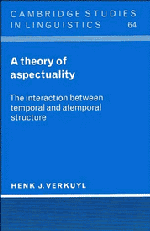
-
Select format
-
- Publisher:
- Cambridge University Press
- Publication date:
- July 2011
- October 1993
- ISBN:
- 9780511597848
- 9780521564526
- Dimensions:
- Weight & Pages:
- Dimensions:
- (228 x 152 mm)
- Weight & Pages:
- 0.675kg, 412 Pages
You may already have access via personal or institutional login
Book description
Sentences may pertain to states or processes or events. They may express duration, frequency, habituality, and many other forms of temporality. How do they do this? It is the aspectual properties of sentences in natural languages which allow the user to express a temporal structure, and Henk Verkuyl presents a unified formal system to account for them. He explains aspectuality in terms of the opposition between terminative aspect and durative aspect, and describes the way in which terminative aspect is compositionally formed on the basis of semantic information expressed by different syntactic elements, in particular the verb and its arguments. The aim is to determine which semantic conditions make a sentence terminative; but at least ten different forms of durative aspectuality are also treated. All are drawn into a theory which can account for both terminative and durative aspectuality together. A Theory of Aspectuality draws together into a coherent whole the author's thinking on the subject over the last twenty years, and will interest all those working on aspect and the semantics of noun phrases. It promises to be a major new contribution to our understanding of the subject.
Reviews
‘ … thoroughly and convincingly argued … [it] deserves to be on the reading list of every semanticist.’
Source: Journal of Linguistics
Contents
Metrics
Full text views
Full text views help Loading metrics...
Loading metrics...
* Views captured on Cambridge Core between #date#. This data will be updated every 24 hours.
Usage data cannot currently be displayed.
Accessibility standard: Unknown
Why this information is here
This section outlines the accessibility features of this content - including support for screen readers, full keyboard navigation and high-contrast display options. This may not be relevant for you.
Accessibility Information
Accessibility compliance for the PDF of this book is currently unknown and may be updated in the future.


